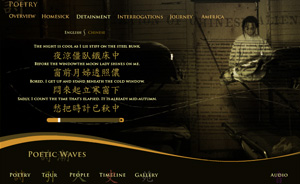talking history | syllabi | students | teachers | puzzle | about us
Poetic Waves: Angel Island
http://www.poeticwaves.net/
Created and maintained by Garman Yip.
Reviewed July 7–12, 2006.
Poetic Waves is a well-researched interactive Web site that explores the Chinese immigrant experience on Angel Island in San Francisco. It is by far one of the best sites available on the subject. It is well grounded in the history of Chinese immigration during the exclusion era, and it effectively captures the legal and emotional bind that many Chinese immigrants faced at that time. They were driven by economic and personal needs to come to the United States, yet they were barred by immigration laws that singled them out for exclusion. A focus of the site is the poetry that some immigrants carved and wrote on the detention barracks walls in the immigration station on the island. Many expressed anger and despair at the harshness of their condition, mostly a product of the U.S. government’s enforcement of the discriminatory Chinese Exclusion Laws (in effect from 1882–1943). Garman Yip, the child of Chinese immigrants, created the site while earning a master of fine arts in new media at the Academy of Art University in San Francisco.

The poetry carved or written onto the walls of the immigrant detention barracks focus on
themes such as homesickness, detention, journey, interrogations, and America.
In building the site, Yip explains (in an article accessible from the Web site and at http://www.academyart.edu/news/ mktg_news0126.html) that he wanted to share this chapter of Asian immigration history with “new generations who otherwise would not know the story of how they became American.” The topic is certainly timely. As I write this review, the U.S. Congress is stalled in its deliberations over immigration reform, and the immigration station on Angel Island (designated a National Historic Landmark in 1997) is currently undergoing a massive renovation to coincide with the centennial of its opening in 1910.
Utilizing a range of creative multimedia techniques, the site highlights the immigrant poetry (displayed in Chinese and in English) and interviews and profiles of immigrant detainees. Relying on rich secondary and primary sources, the site explains the process through which Chinese immigrants were screened and then either granted or denied entry into the United States. Yip worked closely with the staff of the Angel Island Immigration Station Foundation and with noted scholars of the Chinese immigration experience.
The site’s special features, including an interactive timeline, photo gallery, and immigration station tour, make it an especially useful teaching tool for educators of all levels. It is easy to navigate, and its design elements work well. Footage from a documentary film, a dramatic voice-over, and haunting music enrich the experience. The site has already been recognized by the multimedia profession. It was awarded first place in the 2005 SIGGRAPH Student Interactive Media Competition sponsored by the Association for Computing Machinery’s Special Interest Group on Graphics and Interactive Techniques. It was also designated as a Macromedia Site of the Day on January 22, 2005, an honor bestowed on technologically innovative Web sites with timely content.
A CD-ROM version of the Web site is available to educators.
Erika Lee
University of Minnesota
Minneapolis, Minnesota
